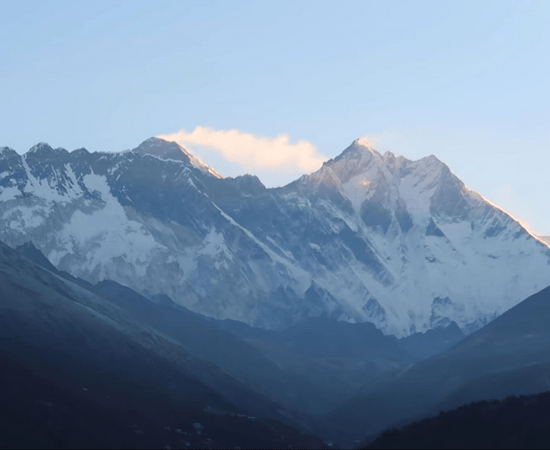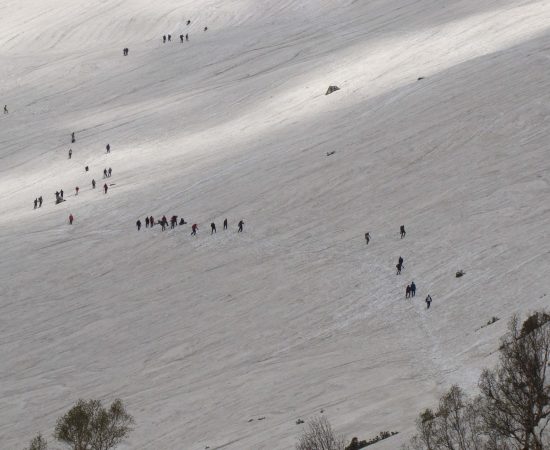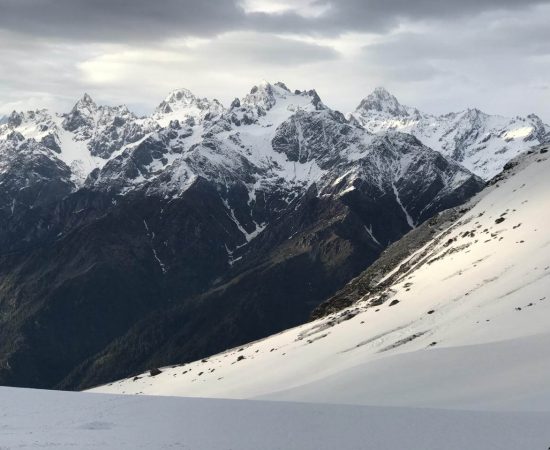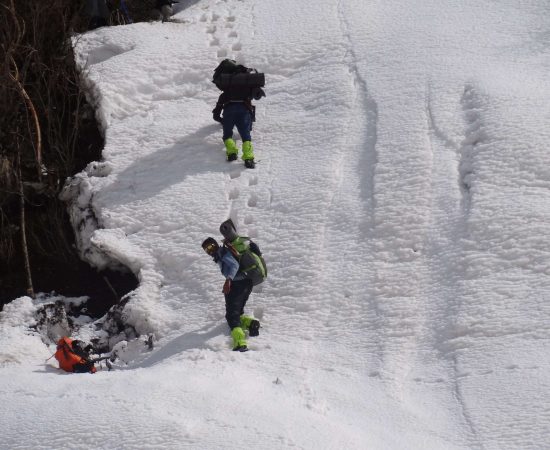Hampta Pass Trek with Chandratal Lake
Manali, Himachal Pradesh
Rated 4.9/5.0 on TripAdvisor. 550 Reviews


Key Highlights
- Altitude : 4270m
- Time : 5 Days - 4 Nights
- Region: Manali
- Best Time: May to October
- Distance: 34Kms
Overview
Hampta Pass Trek with Chandratal Lake
Located in the well-known town of Manali, the Hampta Pass Trek is a stunning mountain that stretches out into the distance from the verdant Kullu Manali valley to the desolate Spiti region. The several days of walking along the path are filled with breathtaking beauty, with lush deodar woods cutting through meadows and a variety of flowers sprouting into the environment. The trail borders radically different expanses. The path was mostly used by locals seeking to cross the Rohtang Pass (13052 ft.) in order to conduct business or engage in other trades, as well as by shepherds moving into highland meadows in search of suitable pastures. It is the most popular trek among adventurous travellers looking for an unforgettable weekend in the Himalayas.
The Hampta Pass journey is very unique and diversified, with lush valleys, glacial lakes, streams, waterfalls, far-off snow patches, and parched, lonely valleys. The route winds through a section of the Rocky Mountains that is bordered by a raging stream that is a tributary of the River Beas and is fed by several torrents. However, these torrents block certain areas, leaving only the choice of navigating the chilly water while understanding the actual nature of the Himalayan region. As the valley gets closer to the passage, there are sometimes opportunities to gaze back at the meandering valley that was left behind. There are moments when a person must pass across a number of icy torrents and rushing streams to reach the big rivers on each side of the valley. At 4200m, the Hampta Pass lengthens, a respectable height that even a novice trekker may reach.
A distinct world, one of arid immensity, may be entered by the Hampta Pass and Chandratal Lake Trek. On this side, the evenings are very cold and the winds are biting, but the scenery and the sky are so clear and clean that one will temporarily forget the cold. At those altitudes, stargazing is often magnificent. The route continues to drop, revealing a stunning view of the lonely Spiti valley and the raging Chandra River flowing tortuously. When we arrive in Chatru, our vehicle will follow us as we go toward the "Chandratal" on Moon Lake. A vacation to Chandratal, with its amazing green lake, is always relaxing and satisfying. As its name implies, the lake is crescent-shaped, and it is around 3 kilometres broad as it laps against the rusty scree rocks. Both pilgrimages and casual tourists circle the lake, which is considered to be sacred and spiritual. The place is quite secluded due to the completely unpaved routes that travel there and back. To reach the civilisation that had been abandoned days before would require many hours of driving backward via rusted roads. The lush foliage will spread out as you cross the Rohtang Pass, resulting in a completely different scene. Once in Manali, it will be time to bid farewell and go for the next location.
Cost Per Person
Key Highlights
- Altitude : 4270m
- Time : 5 Days - 4 Nights
- Region: Manali
- Best Time: May to October
- Distance: 34Kms
Complete
Itinerary of trek
Drive to Prini after reaching Manali, where our representatives will be waiting for you to continue with the activities there. From Prirni, we will travel to Jobri, where our hike will begin. It is a somewhat hilly topography that winds through magnificent streams , green landscapes and deep woods. Chhika, on the other hand, is a shorter acclimatisation trek. After many hours of trekking, the dense forest begins to thin out and the great horizon appears in front of you. One can see the Chhika campground in the distance as the wide countryside starts to take shape. The trek's shortest and simplest path is this one. We will spend the night in campers here.
Prepare for an adventurous climb today after a delicious breakfast. You'll be climbing across studded meadows into a deep valley. The path begins with a brief ascent before becoming somewhat difficult with occasional uphill sections. Before Chhika, the treeline is gone, but the panoramas are still quite wide and expansive. In addition to a diversity of Himalayan flora and wildlife, the vegetation shortens into bushes and shrubs. The Hampta range is abundant in Himalayan plants, making it an intriguing location to learn about herbs if one has the necessary skills. The path travels through a valley that continues to become smaller and a stream that is supplied by the Hampta Glacier. Amidst the enormous snow-capped peaks, one must pass frigid torrential landscape and rocky terrain on the way. We'll trek to a campground that's somewhat high up, where one could suffer their first case of altitude sickness or oxygen deprivation. The viewers camped in Balu ka Gera might gasp at the clear night sky and thinner, very chilly air. The arranged campgrounds are where you'll spend the night.
The day is eagerly anticipated since it will allow us to cross the mountain and explore a new environment. We'll be going early to avoid any severe weather, which tends to occur largely in the afternoon as we reach the Pass. The snow patches will begin to spread out into heavy snow sheets from Balu ka Gera, with moraine buried beneath. As one scree and rocky ridge is climbed after another, the gradient becomes steeper. At the same time, the valley continues becoming wider while the stone mountains keep getting smaller. The pass position is ill-defined, and false ledges might cause one to get ionised because to the unpredictability of the surrounding area. Therefore, it is advised to hike at a moderate pace rather than making extraneous attempts that wear you out. When we turn to gaze back towards Hampta valley, a valley full of revelation, Pass is sometimes close to displaying its majestic views. More than just a physical endeavour, crossing the Hampta Pass empowers one to discover previously untapped talents. On the opposite side of the Pass, the Mighty Deo Tibba, Indrasan, and Mulkila Range may be seen from the summit. We go on while descending via difficult gradient slopes that are largely formed of loose and hard rock material after cooling off at the top of the pass at 4200 metres. There is a danger of falling rocks if a trekker descends too quickly, however when the ground is covered in snow, the risk is reduced since snow slides may be made faster to get to the level zone following the Hampta Pass. As one approaches the opposite side of the pass, they are able to see the dramatic transformation of the landscape, which is now parched and arid, surrounded by rusty brown mountains. Due to the campsite's sparse vegetation, which is only present at Shea Gohru and is supplied by a stream that empties into the Chandra River, it can be seen from a distance. Shea Gohru is like an oasis in such a hostile environment. The campground is a favourite with hikers because the campers are set up along the banks of a creek, surrounded by a lush carpet of highland foliage that is sometimes adorned with hardy flowers. Even though it is quite chilly at night in Shea Gohru, the sky is bright and filled with brilliant stars that cover the campground. Eat supper and get some sleep to prepare for tomorrow.
We must leave early in order to make the most of our time since we need to visit Chandratal Lake, and how much time we spend there depends on when we get to Chatru. In order to prepare for our first step into a stream we will cross barefoot, attempt to move things along quickly at the campground. The only significant hurdle remaining is the creek, which is followed by a modest grade down. On softer ground, we'll plod tortuously down the river. As we approach the base, there is significant lagging and a large slab of snow that must be traversed on an incline. 4x4s provide further guidance. On the banks of the river, Chatru has a few stores that sell food and other necessities. Our car, which will take us to Chandratal Lake, will be waiting for us at Chatru. It is around 40 kilometres away from Chatru and will take two hours to get there. The road terminates with just a short distance to walk to Emerald Lake. Suddenly, the green lake begins to emerge surrounded by desolate mountains. Due to its crescent-shaped form, the lake is known as Chandratal. It is also intended as a pilgrimage route between linked places; it is 3 km wide and takes around 4 hours to complete a circuit. We will return after spending many enjoyable hours at the lake while driving cautiously. By dark, we will arrive at the campground, where we will stay until the departure events.
The walk from Chatru to Manali through Rohtang Pass is nearing its conclusion (13052ft.). Make an early move and inspect whatever a trekker is carrying, then quickly board the vehicle and go. The trip from dry areas to the Kullu Manali Valley's vegetation takes between 5 and 6 hours. We'll go on winding roads that are bordered by stones, rocks, and trees. By the time we get to Manali in the evening, everyone is free to go where they choose.
Enquiry For Group Bookings
Guidelines
➽ Preparation for Trek
As you well know, the great Himalayan trek is one that requires careful preparation, a strategy that allows for enough flexibility to adapt to whatever challenges may arise.
Therefore, here are some things to consider before setting out on your trek:
⦿ Physically – You should start working out at least a month before signing up for a program if you want to be physically prepared for the rigours of a journey. Strengthen your legs by jogging and working out regularly to increase your stamina. To better acclimatise to the environment and increase your resilience on the walk, you should give up smoking and undertake breathing exercises twice a day. Engage in vigorous physical activity, such as playing sports, doing Yoga, or running.
⦿ Mentally –
Getting in shape physically is essential, but mental preparation is just as crucial for a successful walk. Take time to enjoy your regular activities, maintain a healthy diet and sleep schedule, and unwind before embarking on a hike. Predictions regarding the journey should not cause mental worry. Spend time with your closest pals to recharge your batteries and renew your spirit. Pre-trek preconceptions are unwarranted since the first contact with the other trekkers is certain to be a source of inspiration and energy. Conditions during the walk will contribute to the increase in mental readiness. The mental repercussions of physical disadvantages will not be ignored. So, when you hike, pay attention to different regions of your body and purposefully relax them. If you want to enjoy your hike, you should learn to loosen up a little, particularly in the hips. Think about your descent as a simple dance, and enjoy the natural rhythms that the path and your body can discover together gradually, whether you're on a flowing downhill route or a frightening slope. Try out a few new walking techniques to add some fun to your commute without worrying about getting somewhere in particular. Maintaining mental fitness mostly requires a willingness to relax and take in the journey, rather than subjecting oneself to undue stress.
⦿ Technically-
Get the right size hiking boots and go for it, from a technical standpoint. You should make use of 60 litres. To become acclimated to carrying heavy items, it is recommended to utilise a backpack on a regular basis. Get a hiking stick, a water bottle, some thermal socks, a fleece or feather coat, some long pants, a poncho, some flip-flops, and any devices you may need like a camera or a power bank (DSLR or digital camera).
Guidelines
➽ Things to Carry
- Good Trekking Boots: You need sturdy trekking boots with supportive high ankles. Don't bring your running shoes. U can carry extra floaters/flip flops also.
- Wear warm clothing, such three-layer coats, fleece upper, hollow fill or down-filled jackets. Carry full-sleeved T-shirt. Carry cotton hiking trek pants and warm pant for your lower body. Never bring shorts or jeans on a hike.
- Take top and bottom thermals with you.
- Quick dry towel with light weight and Personal toiletries. Suns cream lotion, sanitizer, tooth brush ad toothpaste, lip balm and antibacterial powder.
- Socks: Bring two pairs of regular socks and two pair of wool socks for wearing at night.
- A head torch is required.
- Sunglasses/ Goggle: UV-protected sunglasses are necessary to protect against sunlight and Snow Mountain.
- There should also be a woolen cap / balaclava, cap, neck gaiter cum face mask and warm fleece and waterproof summit gloves since it will be chilly. Keep waterproof gloves on hand since they become wet in the snow.
- Everyone taking part in the activity should have their own lunchbox, spoon, mug and water bottle/ hydration pack of 2 ltr.
- Raincoats/ponchos: Since snowfall and rain are frequent at high elevations, it is important to have one on hand so as to avoid getting wet.
- Trekking bag of 75 ltr with rain cover.
- Walking stik.
- Electronics: camera (optional) USB cable/USB solar charger, charger/earphones, Power bank fully charged.
- Personal first aid box. Emergency ration, energy bars, dry fruit, electoral/Ors
- Required Documents:
a) Registration Form
b) Medical Certificate (signed by a licensed MBBS physician)
c) NOC form (completed by the trekker)
d) 2 passport-size photos
e) ID Proof photo (not PAN)
g) Insurance upto 5 lac..
Guidelines
➽ How to Reach
Manali is conveniently accessible from Delhi. You may travel from Delhi to Manali in 12 to 14 hours by taking an overnight bus (approx 540 KMS). Online ticket sales are available at www.hrtc.gov.in or www.redbus.in. The majority of Volvo private buses leave Delhi between 5 and 8 p.m. due to the distance between Delhi and Manali. At 8.30 p.m., the last government bus leaves from ISBT Kashmere Gate. Volvo buses charge between Rs. 1,200 and Rs. 1,800 every sector from Delhi to Manali.
Getting to Kasol:
Bhunter and Kasol are separated by 25 kilometres, and several buses operate every 15 minutes. On the left bank highway, 25 kilometres from Kasol, there is an additional exit at Bhunter. Between Kullu and Manali is where you may find Hunter. From Manali or Bhunter, you may take a cab or a local bus to Kasol.
The closest train station is at:
The nearest train stations are at Ambala (350 miles) and Chandigarh (450 kilometres) (310 kms).
Advice: Chandigarh to Manali regular Volvo and bus services operate in the evening. Volvo buses from Chandigarh to Manali charge between Rs. 800 and Rs. 1,200 for each sector.
The closest airfield is:
Bhuntar is home to the closest airport. Manali is 52 kilometres from the closest airport. Taxis cost between 1500 and 2,500 rupees to get from Bhuntar to Manali. Air travel between Bhuntar and Delhi is convenient. Indian Airlines, Kingfisher Airlines, MDLR Airlines, and Jagson Airlines all provide flights to Kullu from Delhi and Chandigarh via this airport.
➽ Trip Cost Includes
- Conveyance within the journey.
- Tents that can be shared.
- Advanced and knowledgeable himalayan adventure trips guide.
- Cooks, helpers, and other necessary personnel.
- Vegetarian meals (breakfast, lunch, and dinner) along the journey
- Every organisational prerequisite for a journey
- First aid kit with portal oxygen.
- Camping fees and forest permits.
- All permissions for hiking.
- All meals will be supplied while on the hike. Freshly cooked meals will include a mix of indian, chinese, and continental cuisines.
- Lodging at a hotel, guest house, home, or in tents.
- All of the group's trekking equipment (tents at base camp, use of base camp facilities)
- All trip workers, including porters and mules for everyday items (such as food, tents, and utensils)
➽ Trip cost Excludes
- Airfare or other forms of transportation costs.
- Meals and hotel accommodations.
- Personal costs include washing, cell charging, and lodge showers
- Entry permits or permission for the inner line for foreign participants.
- Personal apparel and hiking supplies, such as liners for sleeping bags and walking sticks, are required.
- Any expenditures associated with rescue efforts or an early expedition departure.
- Guides and sherpa crew are tipped.
- Personal porters to carry hikers' packs
- Personal liability insurance or emergency evacuation costs
- Personal purchases (such as bottles of mineral water, bottled or canned drinks, chocolate, dried fruit, presents, etc.).
- From and to the trailhead, food.
- 5% goods and service tax (gst).
Guidelines
➽ Special Casual Leaves
Government employee can avail the benefit of special casual leave when u join us for a trekking expedition. As per the rule of the pay commission, special casual leave can be availed for up to 30 days in a calendar years for trekking and mountaineering expeditions through a register organization. Himalayan adventure trips are a register adventure tour operator register with Indian mountaineering foundation and Himachal Pradesh tourism. Candidates have to apply for leave at least 30 days before the trek/expedition start.
Testimonials
➽ Provided By The Customers
Amazing Adventure, Life-Changing Vacation
It was the finest journey I've ever been on and without a doubt the best choice I've ever made. It's like being transported to another world, the scenery is so stunning and the environment is so spotless. What a fantastic journey.
Everything about our walk was incredible. In addition, the designated guides and crew members added to the enjoyment. Himalayan Adventure Trips's well crafted schedule for Hampta Pass was excellent in every respect. I am completely happy with Team HAT. Thank you so much for helping to make our vacation special for everyone. The tour guides and service providers did an incredible job. You've contributed to an amazing evening, and I appreciate it.
How useful was this post?
Click on a star to rate it!
Average rating 0 / 5. Vote count: 0
No votes so far! Be the first to rate this post.







